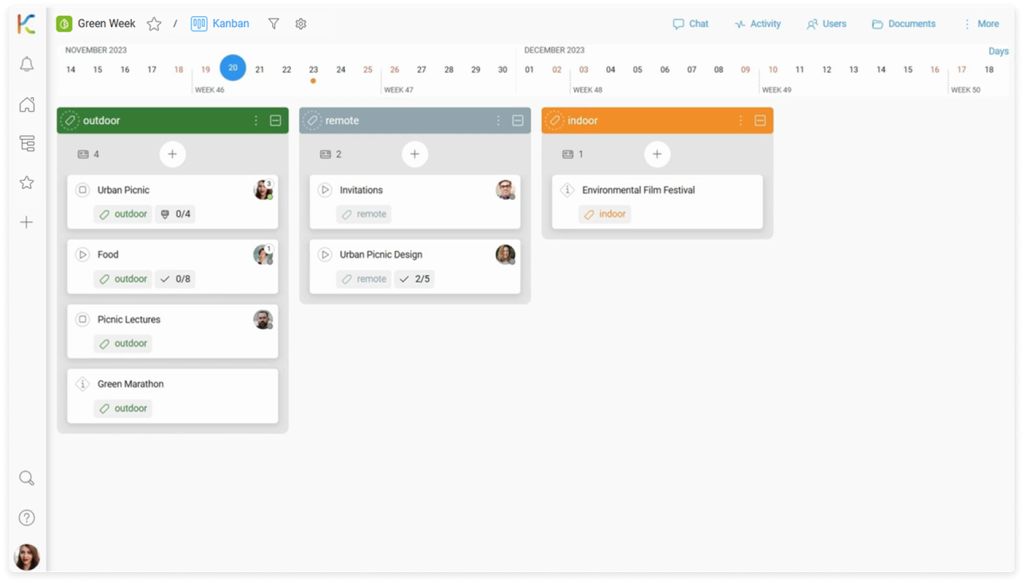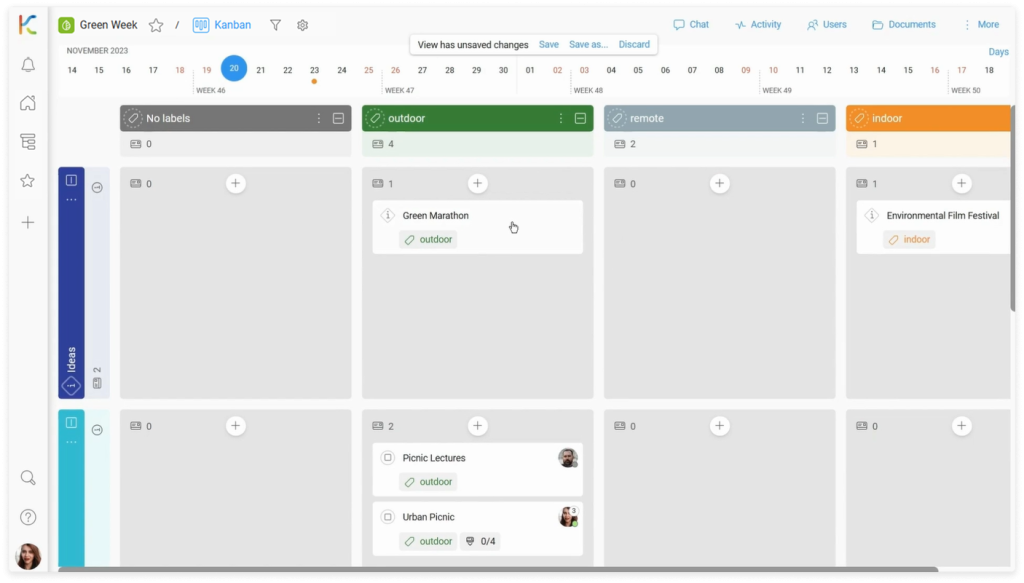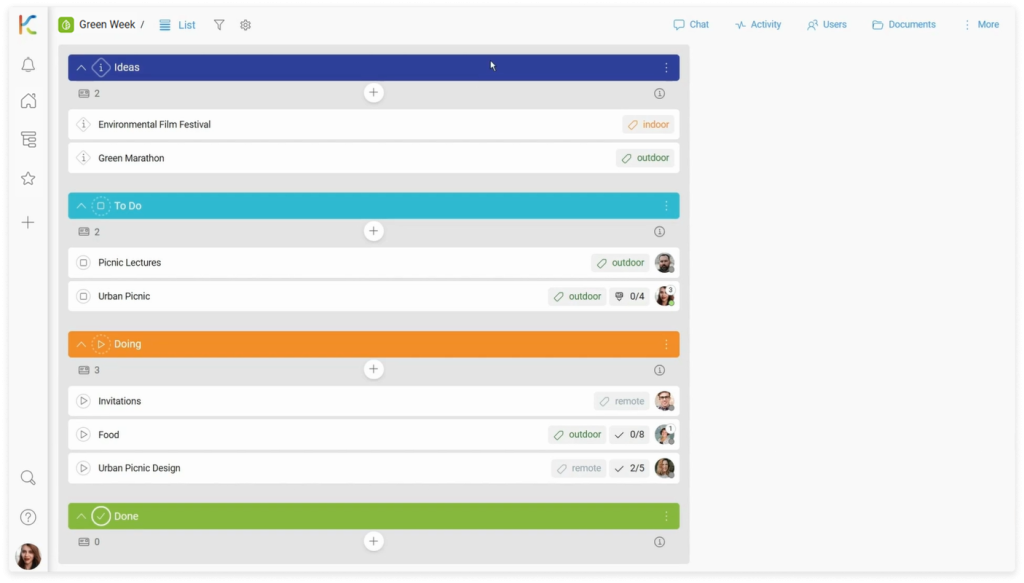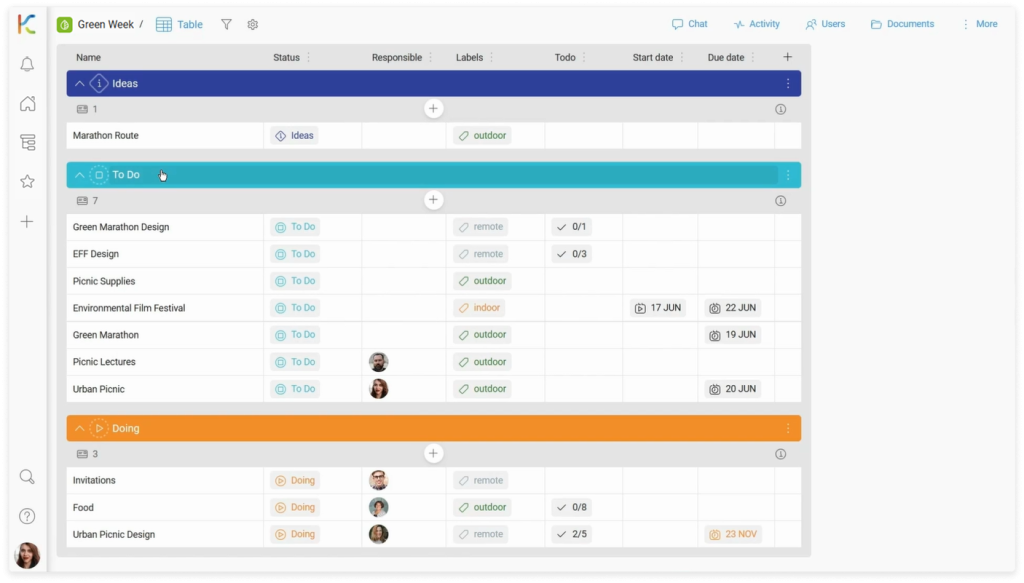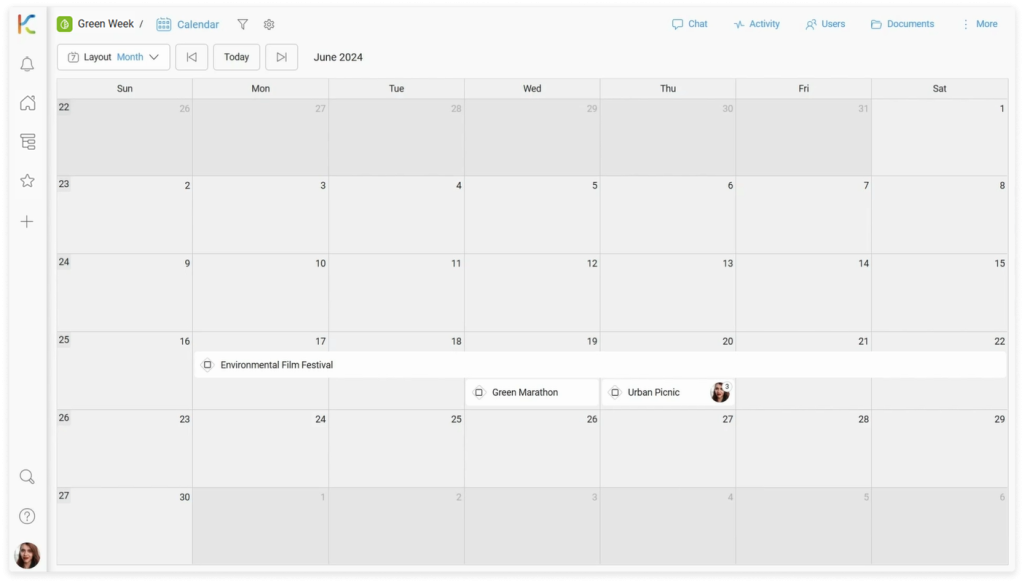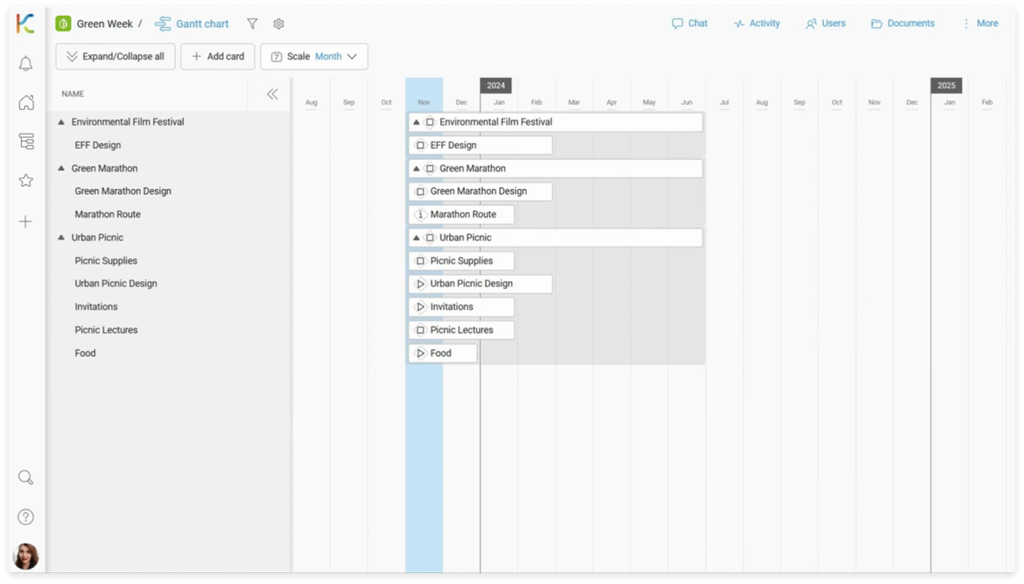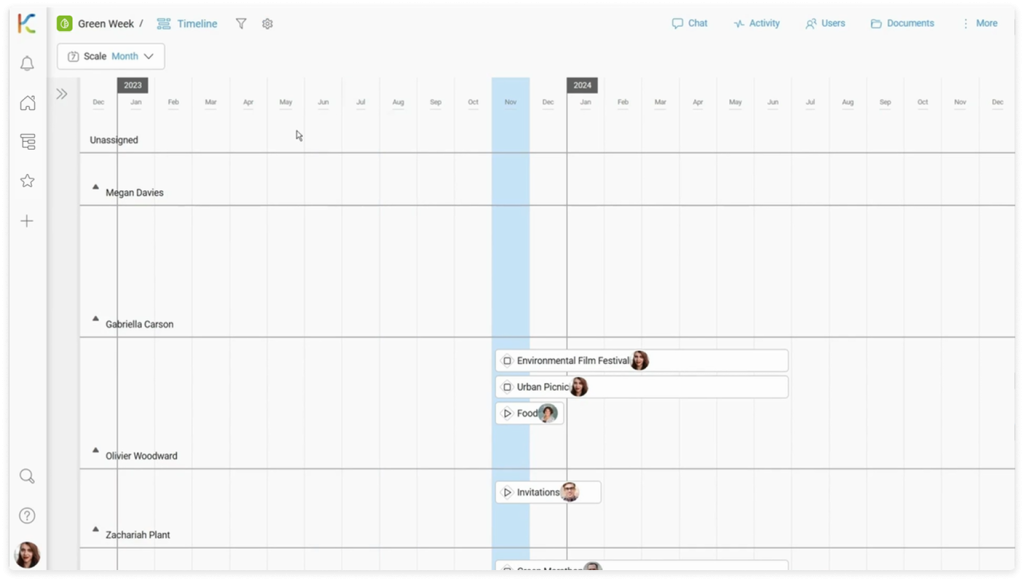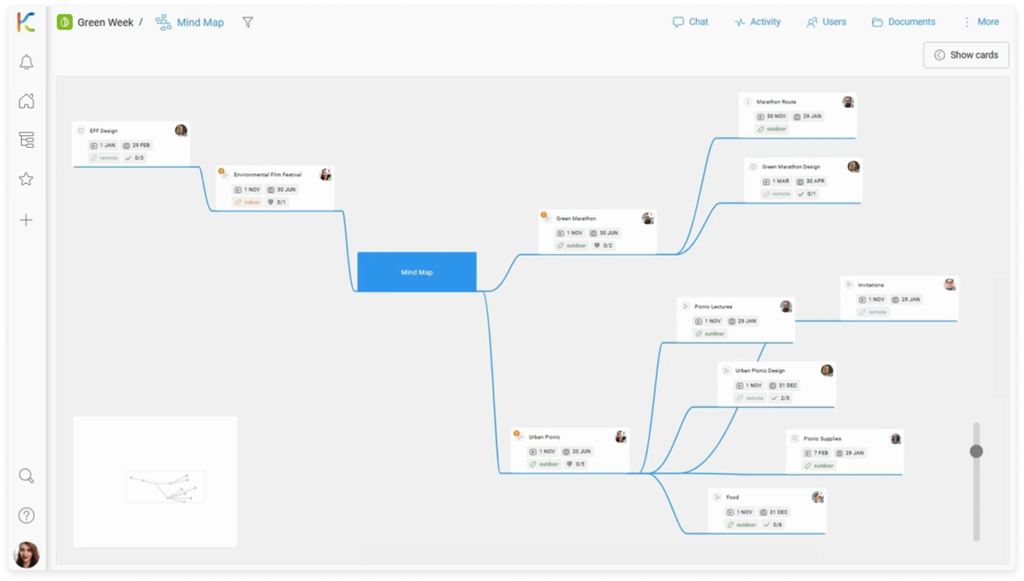Overview
KanBo Getting Started
5. Spaces Views
Learn KanBo > Getting Started with KanBo > Space Views
Learn KanBo > Getting Started with KanBo > Space Views
Space Views
The space view is a visual representation of the contents of a space. It allows you to present the same cards arranged in different ways, depending on what you need at the time. For example, a space view can look like a calendar, a table, or a mind map. In this article, we will walk you through the process of working with space views.
The steps in the video are also described in the following sections.
Article
Space Views
In this article:
Kanban View
You are already familiar with the Kanban view. It is a popular choice for many users. It displays cards grouped horizontally and allows
you to manage them easily by dragging and dropping.
Example: Kanban view with cards grouped by labels.
Kanban Swimlanes
While we are talking about grouping, it is worth mentioning that we can add another dimension of value and get a double grouping – Kanban Swimlanes. Kanban Swimlanes allows you to organize cards both horizontally and vertically at the same time, just like a chessboard.
Example: Kanban view with cards grouped horizontally by labels and vertically by statuses.
The Green Marathon card has the Ideas status and the Outdoor label.
List View
For those who prefer a more straightforward, vertical layout, List View is a great option. It displays cards in a list format, grouped in columns. This view is ideal for quick scanning tasks.
Example: List view with cards grouped by statuses.
Table View
If you want to see more card details at once, try Table view. It resembles a spreadsheet and allows you to view cards as rows in a table. All card details, such as status or assigned users, are displayed in columns that are fully customizable. Table view allows you to quickly compare and contrast different pieces of information. A great option for large projects!
Example: Table view with cards grouped by statuses.
Calendar View
For cards with specific deadlines and time-related aspects, the Calendar view is invaluable. It provides a representation of all card dates and reminders so you can easily schedule, plan, and track your tasks. The one-month or one-week layout helps you focus on current tasks.
Exaple: Calendar view with monthly layout.
Gantt Chart View
For long-term projects, consider using the Gantt Chart view to adjust the scale. This view presents time as a horizontal line and allows for scaling changes from days to months, or even years.
Example: Gantt Chart view with a monthly scale. Three parent cards with its subcards are visible.
This view may be useful for project managers and those who need a comprehensive overview of the project time dependencies.
Timeline View
If you need to prioritize your tasks and focus on what needs to be done first, the Timeline view is your go-to. It displays cards in the same horizontal timeline format. Where’s the difference?
Example: Timeline view with a monthly scale and cards grouped by users.
The timeline view may be helpful in understanding the sequential order of tasks, as it does not take into account card relations. This can lead to more efficient project execution.
Mind Map View
For those who prefer a more visual and intuitive way of organizing information, the Mind Map is a powerful tool. It allows you to graphically represent tasks and their relationships in a hierarchical and interconnected manner. This view is great for brainstorming, planning, and visualizing project structures.
Example: Mind Map view. Three parent cards with their subcards are visible.
It’s a wonderful tool for showing dependencies between tasks – especially parent and child card relations.
Summary
There are seven basic space views. Kanban and List views are popular options for task-oriented work. The first is horizontal, the second is vertical. Table view is great when you’re dealing with a lot of data. The next three views are closely related to time. The Calendar view will work well for short-term projects. Use Gantt Chart and Timeline for long-term ones. If you prefer to arrange the cards according to your own ideas or you are in the planning stage, choose Mind Map.
Follow the video step-by-step
Space Views
To change the space view:
- On the top space bar, click on the current space view name, and then select different space view.
Kanban View
To add vertical grouping (Kanban Swimlanes):
- On the top space bar, go to
 Settings > Vertical grouping, and then select the way of card grouping.
Settings > Vertical grouping, and then select the way of card grouping.
List View
To change the card status in List view:
- With cards grouped by statuses, drag a card and move it to another status grouping (as in the Kanban view).
Table view
To edit card details:
- Click in the field corresponding to the card and its detail you want to edit, and then select desired option.
To add a column:
- In the upper right corner of the table, select the + button, and then select the card detail category.
Calendar view
To schedule a card:
- Drag a card and move it to another date field.
To change the Calendar view layout:
- Go to
 Layout at the top of the space, and then select desired option.
Layout at the top of the space, and then select desired option.
Gantt Chart view
To change the scale in Gantt Chart View:
- Go to
 Layout at the top of the space, and then select desired option.
Layout at the top of the space, and then select desired option.
To manage card dates:
- Hover over a card and drag its left/right edge to change start/due date, then move it to desired timeframe.
To add dates to subcards:
- In the card name section on the left, expand the parent card by selecting the triangle next to its name.
- Click in the desired timeframe field at the level of the subcard.
Timeline view
To hide or expand group of cards:
- On the grouping name (user name in this case), hide/expand its cards by selecting the triangle next to its name.
To manage card dates:
- Hover over a card and drag its left/right edge to change start/due date, then move it to desired timeframe.
Mind Map view
To navigate the Mind Map view:
- To zoom in and out, use the slider at the bottom right side, or use the CTRL + mouse wheel. You can also use the arrow keys on your keyboard to navigate in any direction, as well as the vertical and horizontal mouse wheels if you have them on your mouse.
To add a subcard in the Mind Map View:
- Hover over the card you intend to be the parent card, and then select the + button.
- Enter the name of the card, select the initial status, and then select Create card.
To change the position of a cad in the Mind Map view:
- Drag a card and move it to desired position.
Follow the video step-by-step
Space Views
To change the space view:
- On the top space bar, click on the current space view name, and then select different space view.
Kanban View
To add vertical grouping (Kanban Swimlanes):
- On the top space bar, go to
 Settings > Vertical grouping, and then select the way of card grouping.
Settings > Vertical grouping, and then select the way of card grouping.
List View
To change the card status in List view:
- With cards grouped by statuses, drag a card and move it to another status grouping (as in the Kanban view).
Table view
To edit card details:
- Click in the field corresponding to the card and its detail you want to edit, and then select desired option.
To add a column:
- In the upper right corner of the table, select the + button, and then select the card detail category.
Calendar view
To schedule a card:
- Drag a card and move it to another date field.
To change the Calendar view layout:
- Go to
 Layout at the top of the space, and then select desired option.
Layout at the top of the space, and then select desired option.
Gantt Chart view
To change the scale in Gantt Chart View:
- Go to
 Layout at the top of the space, and then select desired option.
Layout at the top of the space, and then select desired option.
To manage card dates:
- Hover over a card and drag its left/right edge to change start/due date, then move it to desired timeframe.
To add dates to subcards:
- In the card name section on the left, expand the parent card by selecting the triangle next to its name.
- Click in the desired timeframe field at the level of the subcard.
Timeline view
To hide or expand group of cards:
- On the grouping name (user name in this case), hide/expand its cards by selecting the triangle next to its name.
To manage card dates:
- Hover over a card and drag its left/right edge to change start/due date, then move it to desired timeframe.
Mind Map view
To navigate the Mind Map view:
- To zoom in and out, use the slider at the bottom right side, or use the CTRL + mouse wheel. You can also use the arrow keys on your keyboard to navigate in any direction, as well as the vertical and horizontal mouse wheels if you have them on your mouse.
To add a subcard in the Mind Map View:
- Hover over the card you intend to be the parent card, and then select the + button.
- Enter the name of the card, select the initial status, and then select Create card.
To change the position of a cad in the Mind Map view:
- Drag a card and move it to desired position.

